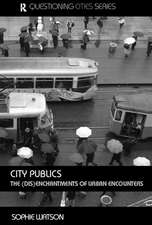Designing for Hope: Pathways to Regenerative Sustainability
Autor Dominique Hes, Chrisna du Plessisen Limba Engleză Hardback – 31 oct 2014
| Toate formatele și edițiile | Preț | Express |
|---|---|---|
| Paperback (1) | 447.44 lei 6-8 săpt. | |
| Taylor & Francis – 23 oct 2014 | 447.44 lei 6-8 săpt. | |
| Hardback (1) | 944.25 lei 6-8 săpt. | |
| Taylor & Francis – 31 oct 2014 | 944.25 lei 6-8 săpt. |
Preț: 944.25 lei
Preț vechi: 1261.16 lei
-25% Nou
Puncte Express: 1416
Preț estimativ în valută:
180.68€ • 189.15$ • 149.50£
180.68€ • 189.15$ • 149.50£
Carte tipărită la comandă
Livrare economică 05-19 aprilie
Preluare comenzi: 021 569.72.76
Specificații
ISBN-13: 9781138800618
ISBN-10: 1138800619
Pagini: 252
Ilustrații: 2 colour illustrations, 312 colour illustrations, 17 colour line drawings
Dimensiuni: 210 x 297 x 19 mm
Greutate: 1.18 kg
Ediția:1
Editura: Taylor & Francis
Colecția Routledge
Locul publicării:Oxford, United Kingdom
ISBN-10: 1138800619
Pagini: 252
Ilustrații: 2 colour illustrations, 312 colour illustrations, 17 colour line drawings
Dimensiuni: 210 x 297 x 19 mm
Greutate: 1.18 kg
Ediția:1
Editura: Taylor & Francis
Colecția Routledge
Locul publicării:Oxford, United Kingdom
Public țintă
Professional Practice & DevelopmentCuprins
Section 1: Introduction Preface 1. Why do we need regenerative sustainability? Section 2: The ethos 2. An ecological worldview 3. Reconnecting with nature Section 3: Process 4. Working with nature 5. Positive Development 6. Regenerative Design and Development Section 4: Action 7. Tools to support regenerative practice 8. The Living Building Challenge Section 5: Bringing it Home 9. Lessons for the reflective practitioner 10. On being a hummingbird Epilogue Resources
Recenzii
"Designing for Hope provides excellent resources and recommendations for further reading. It would be equally at home on the bookshelf of academics, students, and practitioners in any of the disciplines that work in sustainable urban design, and useful for any decision-maker involved in the planning and design of our cities and towns." – Lia Labuschange, Earthworks
"Designing for Hope marshalls ideas, tools, techniques, the social and personal agencies and the motivating ideas required to change direction. Theirs is not a utopian vision – although vision is indispensable – but a set of processes with the potential at least to stop the rot and re-invigorate organic growth and human sensibility." – Malcolm Skilbeck
"Designing for Hope represents a timely, important and necessary contribution to the literature that provides a powerful characterization of current and alternative world views. It also offers a comprehensive coverage of the scope and emphasis of regenerative sustainability." – BRI Review, Raymond J. Cole University of British Columbia, Canada
"It’s a beautiful book, with photography used liberally to enhance and explain the various topics. An international range of case studies from both the developed and developing world shows that embedding the ecological worldview into projects is achievable at both the small project scale through to multi-million dollar developments like Singapore’s Khoo Teck Phuat Hospital." – Willow Aliento, The Fifth Estate
"Designing for Hope marshalls ideas, tools, techniques, the social and personal agencies and the motivating ideas required to change direction. Theirs is not a utopian vision – although vision is indispensable – but a set of processes with the potential at least to stop the rot and re-invigorate organic growth and human sensibility." – Malcolm Skilbeck
"Designing for Hope represents a timely, important and necessary contribution to the literature that provides a powerful characterization of current and alternative world views. It also offers a comprehensive coverage of the scope and emphasis of regenerative sustainability." – BRI Review, Raymond J. Cole University of British Columbia, Canada
"It’s a beautiful book, with photography used liberally to enhance and explain the various topics. An international range of case studies from both the developed and developing world shows that embedding the ecological worldview into projects is achievable at both the small project scale through to multi-million dollar developments like Singapore’s Khoo Teck Phuat Hospital." – Willow Aliento, The Fifth Estate
Descriere
This is a forward looking book on sustainable design that describes problems and then, by providing a different way to conceptualise design and development, leads on to examples of regenerative solutions.

















